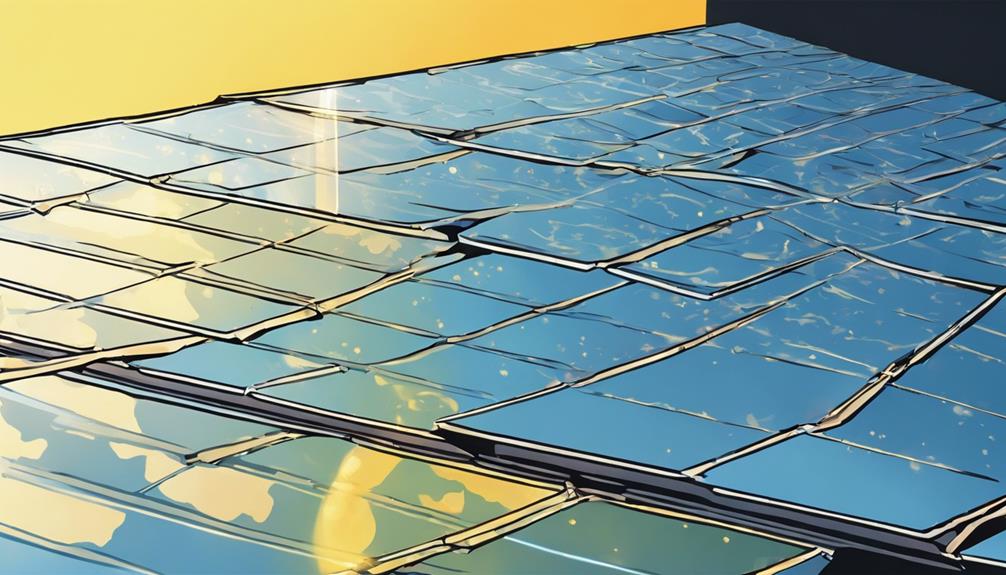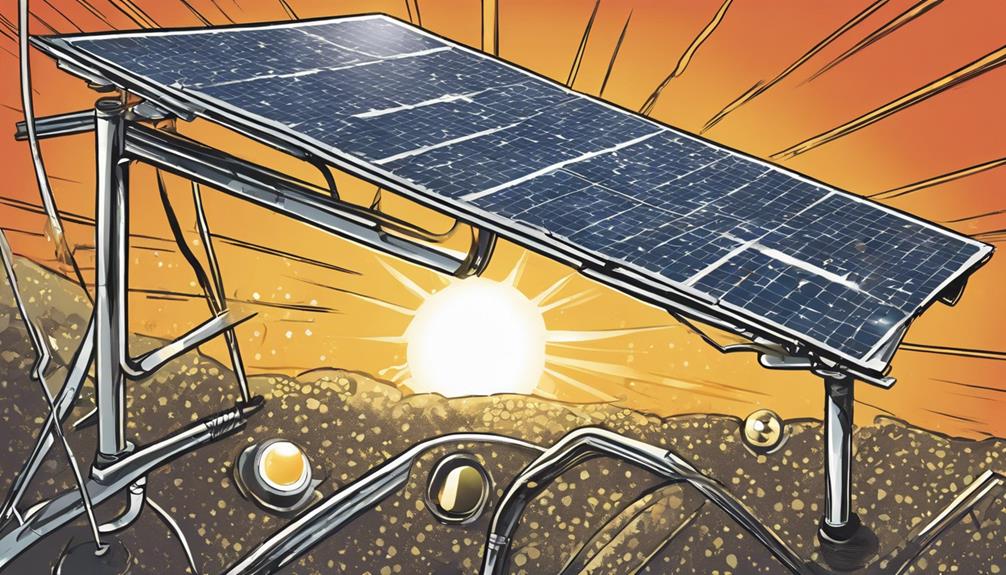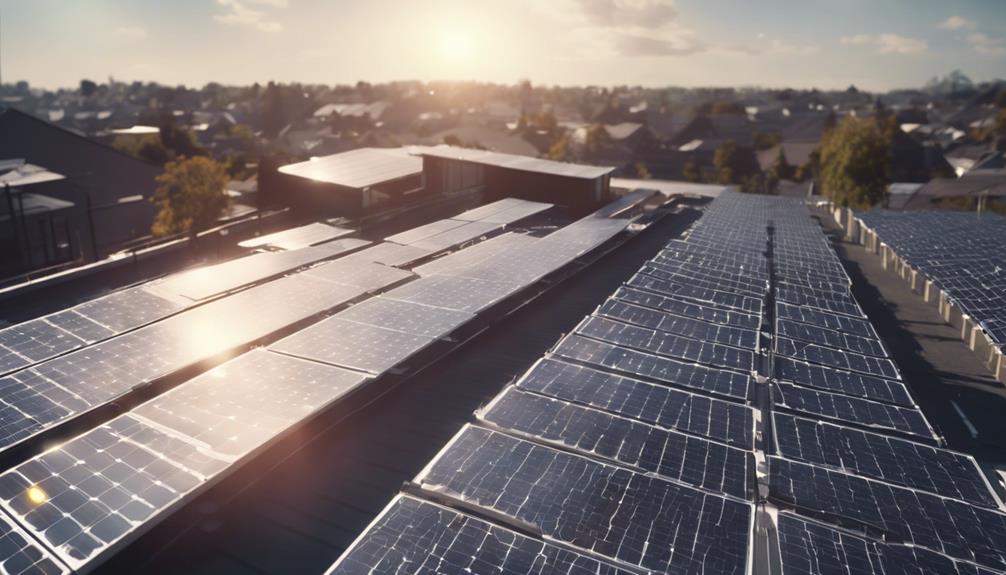I've discovered that incorporating innovative sunlight reflection tactics can greatly enhance solar panel efficiency. By leveraging mirrors, lenses, and polished metal surfaces, I can redirect sunlight onto panels for increased energy output. Mirrors can enhance energy output by up to 20%, while lenses can increase energy production by up to 30%. Nanostructured coatings can also improve light absorption by up to 20%. By combining these techniques, I can boost efficiency by up to 30%. Curious about how to maximize energy harvesting and sustainable practices for the future?
Key Takeaways
- Mirrors and lenses can redirect sunlight onto panels, increasing energy output by up to 20% and 30%, respectively.
- Nanostructured coatings reduce reflection, boosting light absorption by up to 20% and enhancing efficiency by up to 15%.
- Polished metal surfaces can enhance energy output by up to 15%, making them a viable reflection tactic.
- Redirecting sunlight using optical devices and mirrors can optimize panel performance, leading to increased energy harvesting.
- Properly angled and securely fastened panels, combined with regular maintenance, maximize energy output and reduce long-term costs.
Enhancing Solar Panel Performance

The output seems to be missing from your message. Could you please provide the content you'd like me to adjust in terms of paragraph structure? Once you share that with me, I'll be able to help you organize it more effectively.
Maximizing Energy Harvesting Techniques

By incorporating advanced techniques, such as using lenses, optical devices, and mirrors to redirect sunlight, we can greatly maximize energy harvesting from solar panels. These innovative approaches enable us to capture more sunlight and convert it into electrical energy.
For instance, adding another solar panel can increase sunlight reception and capture sunlight from different angles. Additionally, nanostructured coatings can increase light absorption on silicon panels and shield them from environmental factors. Thin glass, plastic films, and holographic films can also redirect sunlight to enhance performance.
Nanostructured Coatings for Efficiency

I'm applying nanostructured coatings to my silicon solar panels to enhance their efficiency, as these innovative coatings reduce reflection and allow more sunlight to be absorbed. This cutting-edge technology has revolutionized the solar energy industry, enabling panels to harness more energy from the sun. By minimizing reflection, these coatings make sure that a greater amount of sunlight is converted into electricity.
Increased light absorption: Nanostructured coatings have been shown to boost light absorption by up to 20%.
Improved efficiency: By reducing reflection, these coatings can enhance solar panel efficiency by up to 15%.
Environmental protection: The coatings also shield the panels from environmental factors, reducing degradation over time.
Enhanced performance: The result is a significant improvement in overall solar panel performance, making them more effective at generating clean energy.
Redirecting Sunlight for Optimal Gain

To maximize energy output, I'm leveraging various sunlight reflection tactics, including the strategic placement of mirrors, lenses, and polished metal surfaces, to redirect sunlight onto my solar panels and capture more energy from the sun. By angling these reflective surfaces just right, I can increase the amount of sunlight that hits my panels, resulting in a significant boost to my energy production.
| Reflection Tactic | Description | Benefit |
|---|---|---|
| Mirrors | Redirects sunlight onto panels | Increases energy output by up to 20% |
| Lenses | Focuses sunlight onto panels | Boosts energy production by up to 30% |
| Polished Metal Surfaces | Reflects sunlight onto panels | Enhances energy output by up to 15% |
Professional Installation and Maintenance

Having my solar panels professionally installed and maintained guarantees that they operate at peak performance, maximizing my energy output and reducing the risk of premature wear and tear.
A well-installed system ensures that the panels are angled correctly to capture the most sunlight, and that all components are securely fastened to withstand environmental factors.
Regular maintenance checks help identify and address any issues before they become major problems. By entrusting the installation and maintenance to the experts, I can rest assured that my solar panels will continue to generate clean energy for years to come.
- Proper installation ensures ideal panel angle and secure fastening
- Regular maintenance checks detect and address issues early on
- Professional installation and maintenance reduce the risk of premature wear and tear
- Maximizing energy output and reducing maintenance costs in the long run
Solar Concentration System Benefits

TEXT:
Here are some ways to improve your time management skills and boost productivity.
- Set specific goals for each day and prioritize tasks based on their importance.
- Break down tasks into smaller, manageable steps to avoid feeling overwhelmed.
- Use tools like to-do lists, calendars, and time tracking apps to stay organized.
- Eliminate distractions by creating a designated workspace and setting boundaries.
- Take regular breaks to avoid burnout and maintain focus throughout the day.
Sustainable Practices for the Future

As we endeavor to create a greener future, implementing sustainable practices in our daily lives becomes essential for reducing our carbon footprint and promoting environmental responsibility.
By incorporating eco-friendly habits into our routines, we can make a significant impact on the planet's well-being.
Here are some ways to get started:
- Implement energy-saving initiatives, recycling programs, and waste reduction strategies within schools and communities to instill eco-friendly habits.
- Encourage student-led sustainability clubs and projects to empower young individuals to take action for the environment.
- Partner with local businesses, municipalities, and organizations to facilitate community-wide solar energy projects and sustainability programs.
- Engage students in sustainable practices to foster a culture of environmental awareness, responsibility, and collective action for a greener future.
Frequently Asked Questions
Can Solar Panels Be Used in Areas With Limited Sunlight?
Yes, solar panels can be used in areas with limited sunlight. While ideal conditions involve direct sunlight, advances in technology have made it possible for panels to generate power in indirect or low-light settings.
How Do Weather Conditions Affect Solar Panel Performance?
I've learned that weather conditions greatly impact solar panel performance; cloudy days, fog, and snow reduce energy output, while extreme temperatures can lower efficiency, making it important to take into account local climate conditions for best performance.
Are Solar Panels Compatible With All Roof Types?
Honestly, I've wondered if solar panels can hang out with any roof type, and the answer is, thankfully, yes Solar panels can be installed on most roof types, including asphalt shingles, metal, clay tiles, and even flat roofs, with some adaptations, of course.
Can Solar Panels Be Used for Water Heating and Cooling?
"I'm happy to report that yes, solar panels can be used for water heating and cooling, offering an eco-friendly alternative to traditional systems, and I've seen impressive results in energy savings and reduced carbon footprint."
Do Solar Panels Require Regular Cleaning for Optimal Performance?
I'm thrilled to explore the world of solar panels. Yes, regular cleaning is a must for peak performance. Dirt, dust, and debris can decrease energy output, so a gentle scrub every 6-12 months keeps them shining bright.
How Can Solar Charge Controllers Improve the Efficiency of Sunlight Reflection Tactics for Solar Panels?
When implementing sunlight reflection tactics for solar panels, it is crucial to consider the solar charge controller ampacity guide. This guide helps in optimizing the efficiency of solar panels by ensuring that the charge controller can handle the maximum current produced by the panels, thereby improving overall performance.
How Can Solar Charge Controllers Help Boost Solar Panel Efficiency?
When it comes to maximizing the efficiency of solar panels, choosing the right ampacity for a solar charge controller is crucial. These devices regulate the flow of electricity from the solar panels to the batteries, preventing overcharging and optimizing energy output. By selecting the appropriate ampacity, solar charge controllers can significantly boost the overall effectiveness of a solar panel system.
How Can Solar Charge Controllers Improve Sunlight Reflection Tactics for Solar Panels?
Solar charge controllers play a crucial role in improving sunlight reflection tactics for solar panels. By choosing the right ampacity, these controllers ensure that the panels receive the optimal amount of power, maximizing their efficiency and overall performance. This leads to a more effective utilization of solar energy and greater cost savings for the user.
Conclusion
As I conclude my exploration of sunlight reflection tactics, I'm convinced that these innovative approaches will play a vital role in tapping into the full potential of solar energy.
I know what you're thinking – 'Isn't reflected sunlight just an extra, not a game-changer?' But trust me, the data shows that even a 10% increase in energy output can make a significant difference in the long run.
By embracing these cutting-edge techniques, we can take a substantial leap towards a sustainable future, and that's a reflection worth celebrating.










